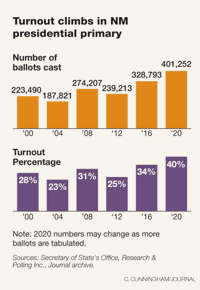Copyright © 2020 Albuquerque Journal SANTA FE – Voter turnout in this week's primary election blew past historical averages in New Mexico, reaching 40% and still climbing, according to unofficial results. The raw number of ballots cast – more than 401,000 – is a record for a primary. Turnout measured as a percentage of eligible voters was also incredibly high – 40%, or six points higher than in 2016 and 15 points higher than in 2012. "I think it's historic, in context," University of New Mexico political science professor Lonna Atkeson said in an interview Friday.

The surge in turnout came amid a public health crisis that erupted in March and, in recent days, civil unrest and protests against police brutality. Brian Sanderoff, president of Research & Polling Inc. in Albuquerque, said an influx of absentee ballots played a role in the increased voter turnout. Earlier this year, the state Supreme Court ordered election officials throughout New Mexico to mail absentee applications to every eligible voter before the election – a directive that came after a legal clash over how to conduct an election during the pandemic. The applications, Sanderoff said, served as a reminder to people that they could vote without leaving the house. Campaigns also seized on the opportunity to "bank" votes from their supporters, he said, by following up with people to remind them to return their ballots. "I think one of the lessons learned here is that when you give voters an easier way of voting, they will take advantage of it," Sanderoff said. "I don't think it's any accident that we had very high turnout and an extremely high proportion of voters doing it by absentee ballot." As of Friday afternoon, election officials had tabulated 401,252 ballots – a record for a primary election in New Mexico, Sanderoff said. The number will climb as some counties wrap up their unofficial count. The turnout percentage – a little over 40% – is the most this century. But it isn't a record, Sanderoff said. A higher proportion of eligible voters turned out in some primary elections in the past, though there were fewer people on the voting rolls back then. In 1992, for example, turnout hit 43%, Sanderoff said. But this year's voter participation, he said, was all the more impressive given that the Democratic and Republican parties already have presumptive presidential nominees. The contested presidential primary four years ago, especially on the Democratic side, attracted sizeable turnout. Even so, Atkeson said, this year's turnout was even higher – among both Democrats and Republicans. The total number of Democratic votes climbed at least 5% in this year's primary compared with 2016, she said, and Republican votes shot up 44%. Donald Trump's candidacy may be a factor, Atkeson said. The "Never Trump" movement among some Republican leaders – following an intense competition for the 2016 presidential nomination – may have dampened voter enthusiasm four years ago, she said. Nonetheless, Atkeson said, Republicans now seem to be rallying around his candidacy. Aside from the presidential race, Democrats and Republicans had plenty of contested races to turn out for, depending on where they lived. The race for the Democratic nomination in the 3rd Congressional District – a seat to be vacated by Democrat Ben Ray Luján, who's now running for Senate – attracted interest from voters in northern New Mexico. Attorney Teresa Leger Fernandez won the nomination. The clash for the Republican nomination in the 2nd Congressional District – where the GOP is eager to reclaim the seat from Democratic incumbent Xochitl Torres Small – was a lure for GOP voters in southern New Mexico. Former state Rep. Yvette Herrell won the nomination. Republicans statewide also had a contested primary to choose a nominee for the U.S. Senate – a race won by Mark Ronchetti, a former television meteorologist. Contested primaries for key legislative seats also attracted voter interest. Five Democratic incumbents and two Republicans lost to challengers this week. It isn't clear, of course, whether the turnout trend will continue in the Nov. 3 general election. The primary election introduced many new voters to absentee ballots – a habit that might take hold for the fall, officials said. But whatever the reason, voters eagerly participated in the primary. "It's definitely historic and out of the park in terms of anything we've seen before," said Alex Curtas, a spokesman for the Secretary of State's Office.



